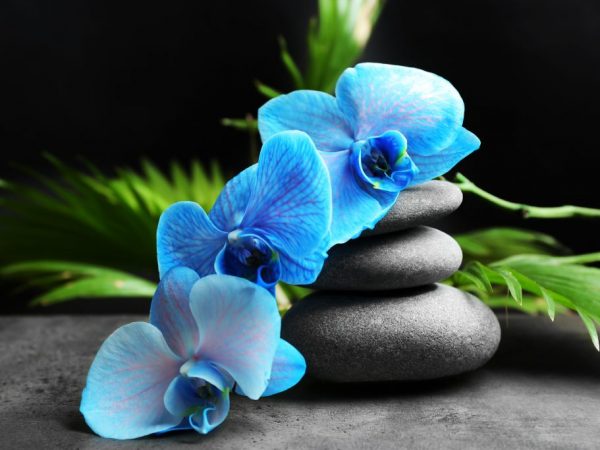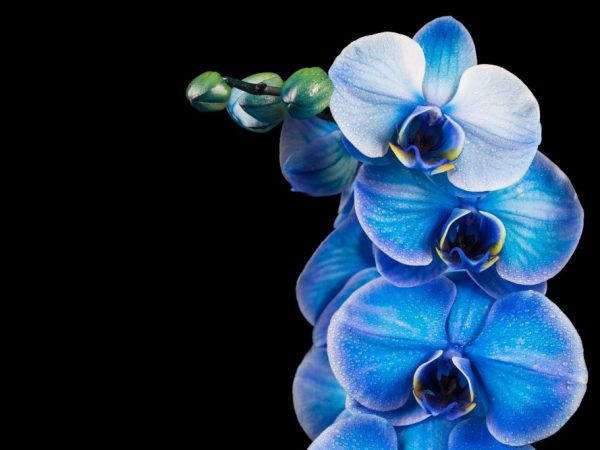Blue and blue orchid care
Blue and blue orchid appeared on store shelves not so long ago, but managed to gain popularity. Consider the secret of the unusual color of the petals, and how to properly care for blue phalaenopsis at home.

Blue and blue orchid care
The secret of blue petals
If blue orchids (phalaenopsis) bloom white, do not be alarmed. Blue orchids do not occur in nature. This color of the petals was achieved thanks to a special technology.
The breeders have not yet succeeded in achieving a stable blue color, so the flowers in each subsequent generation are becoming lighter and lighter.
For staining, only those varieties of phalaenopsis are used, the buds of which are painted white, it is easier to achieve a beautiful blue color on them.
Blue Orchid Care Secrets
Blue and blue orchids need the same care as other varieties of phalaenopsis. The air temperature should be in the range of 18-25 ° C, and the duration of daylight hours is 11-12 hours. The plant is transplanted at least once every 2 years. The size of the pot should match the size of the flowerpot.
It should be planted in a special substrate, which is sold in flower shops. The flower does not tolerate excess moisture, so it should be watered sparingly. If condensation is visible on the pot, then you should not water the plant. Watering from the shower should be done periodically. After such watering, we leave the pot without a pallet in the bathroom, so that all unnecessary moisture is gone. Then we transfer the flowerpot to its usual place.
With active flowering, you need to feed with nutritious mixtures. If after feeding it began to look painful, then a lot of the nutrient mixture was added.
Sometimes the blue orchid dies because the dyeing technology was not followed, which was produced in a flower shop by injecting ink. This procedure has a negative effect on the blue-flowered orchid, which is white in nature.
Phalaenopsis resuscitation

Systematic feeding is required
If blue phalaenopsis is withering away, then it needs to be reanimated as soon as possible:
- Examine the plant carefully for punctures. To obtain blue phalaenopsis, ink or dye is injected into a bud that has just begun to form, a stem or root system.
- If the blue orchid is the result of the injection of ink into the buds, then they need to be removed. If the introduction of ink or paint was made into the stem, but completely remove it. If the ink was injected into the root, then the puncture site is removed. Sometimes, under the influence of chemicals, putrefactive areas appear on the root. You also need to get rid of them.
If the blue phalaenopsis flower has not yet blossomed, and the plant looks sluggish and unhealthy, you need to get rid of it. Chemicals spreading from the bud poison the plant.
- Rinse the roots of the flowerpot under running water at room temperature. Sprinkle all the cuts with wood ash.
- Transplant the flowerpot into a new substrate.Before transplanting, the pot must be thoroughly washed using detergents.
You can not plant a flowerpot in old soil. It is saturated with chemicals that have a negative effect on the roots.
From the first days of the appearance of a blue or blue orchid in the house, you take care of it carefully: once every few months, feed it with special nutrients and change the substrate.
Choosing a blue orchid
If the blue orchid has won the heart, then it should be purchased at specialized exhibitions. This miracle is worth a lot in comparison with the varieties existing in nature. If a plant is offered at a low price, then there is a high probability that they have saved on dyeing technology.
Having figured out whether blue orchids exist in nature, it becomes clear that such plants cannot be on store shelves. An intensely colored flowerpot will not survive even with careful maintenance. Refuse such a purchase.
There are flowers on sale with veins of blue, pink, purple and other colors - this is a natural color.
Important points
Due to the fact that a real blue orchid does not exist, some people try to paint the flowerpot at home. This is not worth doing. In the absence of knowledge of floristry, it will not be possible to achieve a rich color, and irreparable damage to the flowerpot will be done.
The most common are dyed blue phalaenopsis orchids of two varieties: Wanda, Cattleya. Wanda is the most capricious variety. Its buds are dark blue. She is demanding on air humidity. Wanda feels comfortable at a humidity of 70-90%. It is difficult to provide such in a city apartment. Cattleya is less whimsical and more fragrant, in the first generation it produces beautiful blue buds.
Conclusion
The blue orchid does not exist in nature, the flowers are dyed. There is information that blue orchids were bred and grown in Japan, but it is true or a myth is still unknown, domestic breeders fail to grow an analogue.


